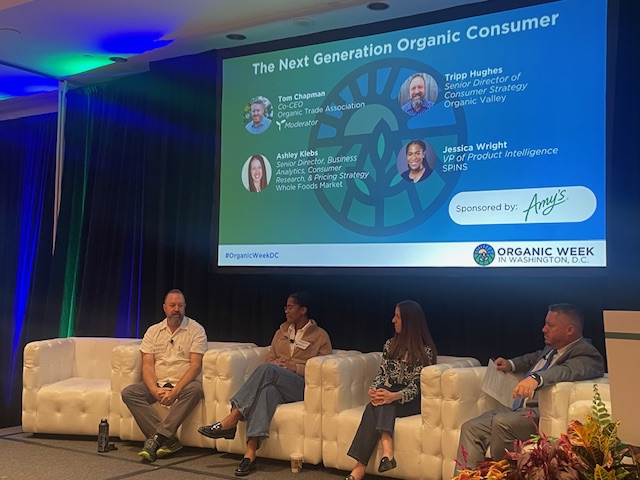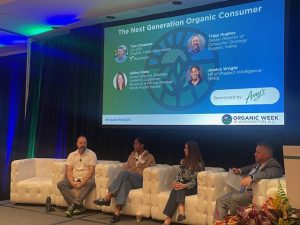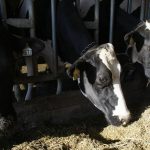OTA to urge consumers to look for USDA organic seal

Organic-RFP-092225
The Organic Trade Association announced today that it has launched a campaign to urge consumers to look for the Agriculture Department’s organic seal to make sure they are getting truly organic products.
At the group’s 40th annual meeting in Washington, Sandy Pfaff, the OTA director of media relations, showed a video that she has said has already been used in online advertising and will be coming to stores soon. The message, Pfaff said, is “look for the seal.”
Attendees at the meeting said that companies whose products are not certified organic by the Agriculture Department are making claims that are close to organic but not organic, such as non-GMO or regenerative. The use of terms that make claims similar to organic is confusing to consumers, they said.
Tripp Hughes, senior director of consumer strategy for Organic Valley, told the other attendees, “We have to continue to take the gloves off” in dealing with competitors. Hughes said that when consumers realize that they are not getting genuinely organic products but have been paying higher prices for what they thought was organic, “they get angry.”
The “penetration” of organics among Gen Z consumers is “tremendous,” Hughes said, but their commitment to the products is not as strong, so it’s important to tell them to look for the seal.
The organic message has “evolved” over the past 40 years, Hughes added. In the 1970s organic consumers cared about saving farms but now the market is broader and the message needs to be about the food, he said.
Ashley Krebs, senior director for business analytics, consumer research and pricing strategy for Whole Foods Markets, added that Gen Z consumers are “quick to suss out” a company if it is not living up to its values.
Jessica Wright, vice president of product intelligence for SPINS said Gen Z consumers are following their dietary preferences.
In a keynote presentation, Sprouts Farmers Market CEO Jack Sinclair said he still sees a bright future for organics. Consumers are more educated and are rejecting labels that people need a chemistry degree to understand, he said.
One of the major problems facing organics is supply, Sinclair said. The United States is importing too much organic food, he added. He suggested that because land must be in transition for three years before farmers can sell their production as organic, retailers should make five- to seven-year commitments to farmers to convince them to convert their land to organics.
But another attendee said longer commitments won’t be enough to convince grain farmers to convert to organic unless prices go up. Yet another attendee said conventional farmers are too protected by crop insurance payments to make the transition.
Sinclair noted that Sprouts now has stores in 24 states but is planning to open 35 stores near its seven distribution centers. Sprouts favors local sourcing but “the dynamics of sourcing locally is different if you are in Chicago than in southern California.”
On a panel of CEOs, Craig Stevenson of Lundberg Family Farms said that “the convergence of left and right” on eating healthier is one of the best things that has happened to the organic industry.
But Lundberg noted that the yield on organic farms is about half that of conventional agriculture and he said there is too little research being done on increasing organic yields. Lundberg has its own nurseries where research is taking place, he said.
Shawna Nelson of Organic Valley said that dairy farmers are worried about expanding because they remember a surplus of organic milk. Nelson also said organic dairy is “harmed” by the current milk marketing order system.
Discussing both start ups and older retailers, Krebs said they must be “customer-obsessed.”







